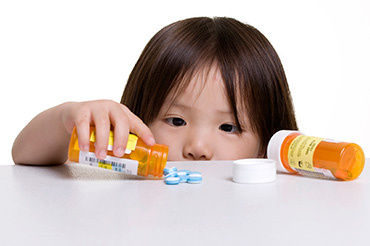Poisoning Prevention

Definition: A poisoning is injury or death that occurs when a person is exposed to any natural or man-made substance that has an undesirable effect. A poison can be swallowed, inhaled, or absorbed through the skin (Centers for Disease Control and Prevention [CDC], 2017).
Magnitude of the Problem
On average, approximately 3 children and adolescents ages 0-19 die from poisoning each day. Between 2016 and 2019, 483 children ages 0-9 and 3,867 adolescents ages 10-19 died from poisoning (CDC WISQARS, 2016-2019).
- According to the 2016-2019 CDC WISQARS data,
- Among children ages 0-9, most poisoning deaths were unintentional (41%), followed by undetermined (31%) and homicide (29%). Approximately three in four poisoning deaths were related to drug poisoning.
- Among adolescents ages 10-19, most poisoning deaths were unintentional (75%), followed by suicide (19%) and undetermined (5%). Nine in ten poisoning deaths were related to drug poisoning.
- The 2019 Annual Report of the American Association of Poison Control Centers' National Poison Data System (Gummin et al., 2019) identified the following substances as the top five most common exposures in children ages less than 5: cosmetics/personal care products (11%), household cleaning substances (11%), analgesics (9%), foreign bodies/toys/miscellaneous (7%), and dietary supplements/herbals/homeopathic (5%).
- A study based on the CDC’s State Unintentional Drug Overdose Reporting System (SUDORS) data from July 2019–December 2021 found that among adolescents ages 10-19, approximately 90% of drug poisonings deaths involved opioids, and 84% involved illicitly manufactured fentanyls (Tanz et al., 2022).
Prevention
Educating the public on proper storage and disposal of medications is important, including education around keeping medicine, chemicals, cleaning products and batteries locked, out of sight and out of reach of children. School-based and family-focused programs on resilience and connectedness of adolescents may help prevent substance misuse and related harms. Strengthening policies and practices related to the Prescription Drug Monitoring Program (PDMP), Good Samaritan Laws, and Naloxone and other harm reduction programs (e.g., overdose education, naloxone distribution, fentanyl test strips and syringe services) can also save lives.
Poison Control Centers can be valuable resources in helping to prevent poisonings in communities. They can also be cost-saving services for states: for every dollar spent on Poison Control Center services, $8 is saved in benefits to society (Children’s Safety Network, 2022). Save the toll-free Poison Help line number in your phone to connect to your local poison center: 1-800-222-12
Sources
- Centers for Disease Control and Prevention. (2017). Poisoning. Retrieved from https://www.cdc.gov/pictureofamerica/pdfs/Picture_of_America_Poisoning.pdf
- Centers for Disease Control and Prevention. (2016-2019). Web-based Injury Statistics Query and Reporting System (WISQARS).
- Children’s Safety Network. (2022). Injury Prevention: What Works? A Summary of Cost-Outcome Analysis for Injury Prevention Programs. Retrieved from https://www.childrenssafetynetwork.org/sites/default/files/InjuryPrevention-WhatWorks.pdf
- Gummin, D. D., Mowry, J. B., Beuhler, M. C., Spyker, D. A., Brooks, D. E., Dibert, K. W., Rivers, L. J., Pham, N. P. T., & Ryan, M. L. (2020). 2019 Annual Report of the American Association of Poison Control Centers' National Poison Data System (NPDS): 37th Annual Report. Clinical toxicology, 58(12), 1360–1541.
- Tanz, L. J., Dinwiddie, A. T., Mattson, C. L., O’Donnell, J., & Davis, N. L. (2022). Drug Overdose Deaths Among Persons Aged 10–19 Years — United States, July 2019–December 2021. Morbidity and Mortality Weekly Report, 71, 1576–1582.